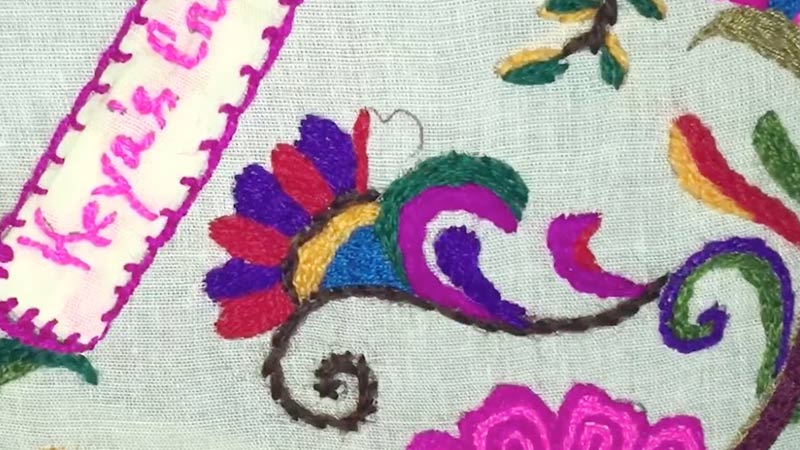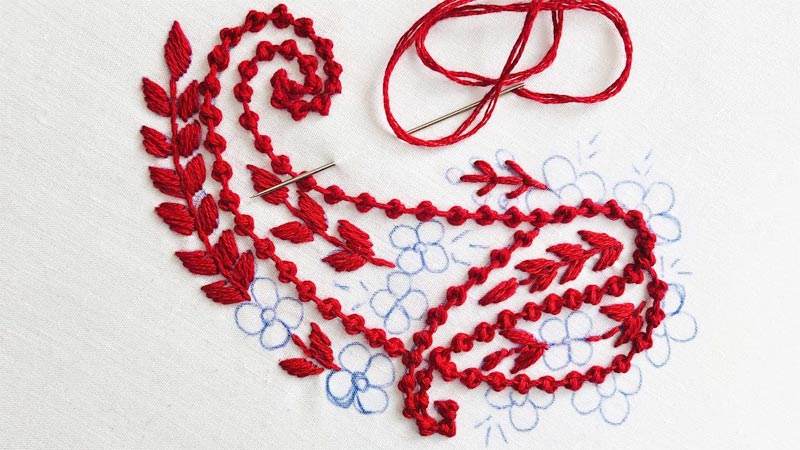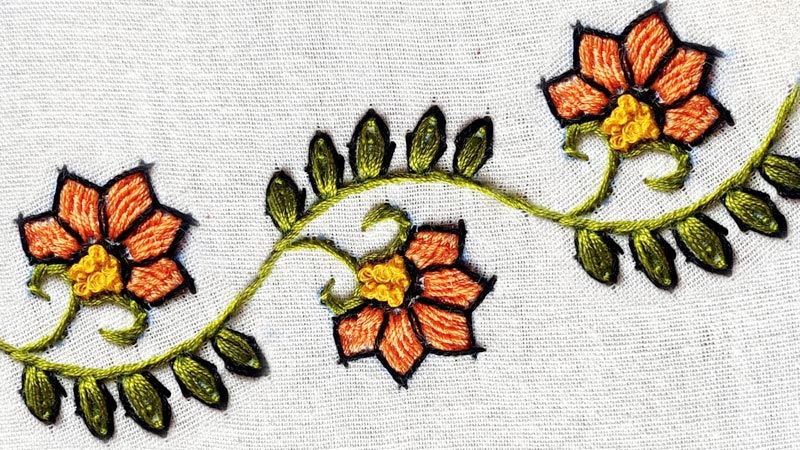Kashmiri embroidery, a time-honored artistry that traces its origins to the picturesque Kashmir Valley in the Indian subcontinent, is a stunning testament to the marriage of nature’s inspiration and human creativity.
This intricate needlework tradition is celebrated for its breathtakingly detailed patterns, vibrant colors, and the masterful interplay of silk and Tilla threads, which lend a regal opulence to its designs.
It draws its inspiration from the region’s lush landscapes, featuring motifs of chinar leaves, flowers, birds, and geometric patterns.
This centuries-old craft passed down through generations, stands not only as a symbol of Kashmir’s rich cultural heritage but also as a globally recognized art form that continues to captivate enthusiasts worldwide.

What Is Kashmiri Embroidery?
Kashmiri embroidery, also known as Kashmiri Tilla or Kashida embroidery, is a traditional and exquisite form of needlework that originates from the region of Kashmir, a picturesque valley nestled in the northern part of the Indian subcontinent.
This intricate and artistic embroidery style has a rich history dating back several centuries and is celebrated for its timeless beauty and craftsmanship.
Key characteristics of Kashmiri embroidery include:
Intricate Patterns and Designs
Kashmiri embroidery is a reflection of the breathtaking natural beauty that surrounds the region. The motifs and designs found in this embroidery often draw inspiration from the local flora and fauna.
You’ll frequently encounter designs featuring chinar leaves, the famous Kashmiri pinecone, or vibrant representations of saffron flowers.
Additionally, geometric patterns and abstract designs are created with painstaking attention to detail, making each piece of embroidered fabric a work of art.
Silken Threads
The use of silk threads is integral to the luxurious appeal of Kashmiri embroidery. These threads come in a wide spectrum of colors and exhibit a natural sheen, adding depth and richness to the embroidery.
The artisans skillfully blend various shades and textures to create a harmonious interplay of colors in their designs. The result is a visual and tactile experience that is both exquisite and captivating.
Tilla (Gold and Silver Thread)
The inclusion of Tilla, or gold and silver metallic threads, further elevates the opulence of Kashmiri embroidery.
These threads are traditionally woven into the fabric, creating a captivating contrast with the fine silk threads.
Tilla work is often used for outlining motifs, borders, and in the central design, adding a regal and ornate touch to the embroidery.
Variety of Stitches
Kashmiri embroidery relies on a diverse array of stitches, each serving a unique purpose. The satin stitch is employed for filling in larger areas with a smooth, polished finish.
The chain stitch is used for outlining and creating intricate patterns, while the stem stitch adds dimension and texture.
The herringbone stitch is often utilized for creating geometric designs, ensuring that the embroidery maintains its precision and aesthetic appeal.
Versatility
Kashmiri embroidery is not confined to a specific type of fabric. While it is most famously associated with the warm and luxurious Pashmina shawls, it also adorns a wide range of textiles.
You can find it on sarees, jackets, dresses, pillow covers, tablecloths, and even accessories like handbags.
The versatility of Kashmiri embroidery enables it to complement and elevate a wide array of products.
Cultural Significance
The tradition of Kashmiri embroidery is deeply rooted in the culture of the region. Passed down through generations, it is not just an art form but a part of the identity of the Kashmiri people.
Artisans and craftspersons take great pride in preserving and propagating this traditional craft. It is not just a means of livelihood but a way of connecting with their heritage and expressing their creativity.
Global Appeal
Kashmiri embroidery has transcended borders and is sought after worldwide. Its timeless beauty and intricate designs have made it a symbol of luxury and sophistication.
Fashion designers often incorporate Kashmiri embroidery into their collections, ensuring that this unique art form continues to enjoy global recognition and appeal.
Pros of Kashmiri Embroidery

Kashmiri embroidery, with its rich heritage and intricate craftsmanship, offers numerous advantages and pros, making it a highly valued art form and product.
Here are some of the key pros of Kashmiri embroidery:
Artistic Beauty
Kashmiri embroidery is celebrated for its artistic beauty, which stems from the meticulous attention to detail in its designs.
The motifs, often inspired by the region’s natural surroundings, display an extraordinary level of intricacy.
These designs are a visual treat, portraying flowers, leaves, birds, and abstract patterns with such precision that they become pieces of art in themselves.
The vibrant and contrasting colors, achieved through the use of silk threads, lend a striking and eye-catching quality to the embroidery.
Cultural Heritage
One of the most profound pros of Kashmiri embroidery is its role in preserving and celebrating the rich cultural heritage of the Kashmir Valley.
This embroidery style has been passed down through generations, and it carries with it the history and traditions of the region.
It is not merely an art form but a symbol of the identity of the Kashmiri people and their deep-rooted cultural values.
Versatility
Kashmiri embroidery’s versatility is a significant advantage. It can be applied to a wide array of fabrics and products, including shawls, sarees, jackets, dresses, pillow covers, tablecloths, and even accessories like handbags.
Its adaptability ensures that it can cater to various occasions, styles, and preferences.
Global Appeal
The global appeal of Kashmiri embroidery is a testament to its universal allure. Collectors, fashion enthusiasts, and designers from around the world seek out this unique craft.
Its ability to transcend borders and cultures ensures that it remains a highly regarded and valuable commodity.
Employment Opportunities
Kashmiri embroidery provides employment opportunities for a considerable number of skilled artisans, particularly women.
Many artisans work from their homes, allowing them to earn a livelihood while maintaining their traditional skills. This economic empowerment is significant, particularly in a region like Kashmir.
Economic Contribution
The sale of Kashmiri embroidered products contributes significantly to the local and regional economy.
It not only sustains the livelihoods of artisans but also supports the craft industry, providing opportunities for economic growth and development.
Handmade and Sustainable
Kashmiri embroidery is inherently sustainable. It relies on traditional handcrafting techniques, employing natural materials and dyes.
This eco-conscious approach aligns with modern preferences for sustainable and environmentally friendly products.
High Quality and Durability
The combination of intricate handwork, the use of luxurious silk threads, and the incorporation of Tilla threads results in products of exceptionally high quality.
Kashmiri embroidered items are not only beautiful but also durable and long-lasting, ensuring they can be cherished for generations.
Unique Personalization
Every piece of Kashmiri embroidery is unique due to the artisan’s personal touch. The handcrafted nature of this art form means that no two pieces are exactly alike, providing customers with custom-designed, one-of-a-kind items.
Empowerment of Artisans
The continued demand for Kashmiri embroidery empowers artisans to refine their skills and knowledge.
By passing down these skills through generations, the craft is preserved, and artisans can continue to benefit from the tradition.
Contribution to Fashion Industry
Fashion designers frequently incorporate Kashmiri embroidery into their collections, which enhances the overall appeal of their creations.
This collaboration strengthens the connection between traditional craftsmanship and contemporary fashion, adding depth and cultural richness to the industry.
Cons of Kashmiri Embroidery

While Kashmiri embroidery is celebrated for its beauty and cultural significance, it also has some cons and challenges that need to be considered.
Here are the cons of Kashmiri embroidery:
Labor-Intensive
Kashmiri embroidery is a labor-intensive craft that requires extraordinary attention to detail. Each piece is meticulously crafted by skilled artisans, which involves long hours of focused work.
The labor-intensive nature of this craft results in higher production costs. As a result, the final products tend to be more expensive, limiting their accessibility to a wider range of consumers.
Skill-Dependent
The art of Kashmiri embroidery demands a high level of skill and expertise. It takes years of training and practice to become proficient in this craft.
The limited availability of skilled artisans and the challenge of passing down this intricate knowledge to the next generation is a concern.
Without a new generation of artisans to carry on the tradition, there is a risk that this heritage could be lost over time.
Time-Consuming
Due to the intricate and elaborate nature of the embroidery, the production of Kashmiri embroidered items can be time-consuming.
This can lead to delays in fulfilling orders and may affect the viability of businesses that rely on quick turnaround times for their products.
Limited Mass Production
The labor-intensive and time-consuming nature of Kashmiri embroidery makes it challenging for mass production.
This limits the production capacity for these products, potentially resulting in unmet demand and restricting the growth of the industry.
High Cost
The use of high-quality materials, including silk threads and Tilla, and the skilled labor involved contribute to the relatively high cost of Kashmiri embroidered products.
While this cost reflects the craftsmanship and quality, it may place these items out of reach for many potential buyers.
Sustainability Concerns
The demand for Kashmiri embroidery has led to increased pressure on resources like silk, potentially raising sustainability concerns.
Balancing the need for materials with the preservation of the craft’s authenticity and ecological considerations is an ongoing challenge.
Economic Challenges
The region of Kashmir, where this art form originates, has faced decades of conflict and political instability.
These challenges have had a negative impact on the local economy, making it difficult for artisans to sustain their livelihoods and preserve this cultural tradition.
Competition from Machine Embroidery
In an era of technological advancement, machine embroidery has become a significant competitor to traditional handcrafted embroidery.
Machines can produce intricate designs quickly, potentially reducing the demand for handmade embroidery.
However, the machine lacks the depth, soul, and uniqueness that come with the authentic handcrafted nature of Kashmiri embroidery.
Cultural Appropriation
The popularity of Kashmiri embroidery has led to instances of cultural appropriation, where non-Kashmiri entities imitate or commercialize this traditional craft without proper credit or respect for its cultural significance. This can exploit the art and its cultural heritage.
Loss of Heritage
As younger generations are drawn to more lucrative or modern professions, the transmission of skills and knowledge from one generation to the next becomes uncertain.
This raises concerns about the long-term preservation of this rich cultural heritage and the potential loss of a centuries-old tradition.
FAQS
Is Kashmiri embroidery the same as Aari embroidery?
No, Kashmiri embroidery and Aari embroidery are distinct techniques.
While both are traditional Indian needlework styles, Kashmiri embroidery is characterized by intricate silk and metallic threadwork, while Aari embroidery uses a hooked needle to create fine chain stitch patterns.
What is the history of Kashmiri embroidery?
Kashmiri embroidery has a long history dating back several centuries. It is believed to have evolved during the Mughal period and has been passed down through generations, becoming an integral part of the cultural heritage of Kashmir.
Are there regional variations in Kashmiri embroidery?
Yes, there are regional variations in Kashmiri embroidery. Different regions within the Kashmir Valley may have their own unique motifs and designs, although the overall technique and craftsmanship remain consistent.
Can I learn Kashmiri embroidery as a hobby?
Yes, you can learn Kashmiri embroidery as a hobby. Many workshops and classes are available to teach the basics of this art form.
To Recap
Kashmiri embroidery, a labor-intensive and artful craft originating from the breathtaking Kashmir Valley, is an embodiment of intricate beauty and cultural heritage.
Its exquisite designs, often inspired by nature, incorporate silk threads and metallic Tilla, creating a luxurious sheen. The diverse stitches, from satin to chain, contribute to its timeless allure.
While it faces challenges such as high production costs and limited artisans, Kashmiri embroidery stands as a symbol of tradition and elegance, captivating enthusiasts worldwide.
Preserving this rich heritage and empowering the skilled artisans is essential to ensure that this remarkable needlework continues to flourish and inspire generations to come.
Leave a Reply